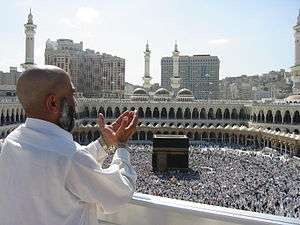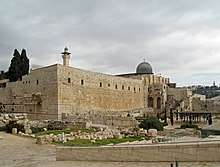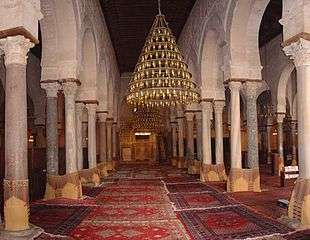Haram (site)
Haram (Arabic: حرم, romanized: ḥaram, lit. 'sanctuary') is one of several homographs originating from the triliteral Semitic root Ḥ-R-M. The word literally means "sanctuary," commonly used by Muslims to refer to the holy sites of Islam and the area surrounding them, within which the entry of non-Muslims is not permitted. In addition to the restriction on movement of non-Muslims, there are several other rules which Muslims within the area must follow.


Another meaning of the word which was used in the past but has since fallen out of use, include an "inviolable/protected zone," referring to an area in which the number of residing families was limited, attributed to the idea of carrying capacity and early forms of nature reserves, and to the prayer hall of the mosque.
Etymology
The Arabic language has two separate words, ḥaram (Arabic: حَرَم) and ḥarām (Arabic: حَرَام) both derived from the same triliteral Semitic root Ḥ-R-M. Both of these words can mean "forbidden" and/or "sacred"[1]:471 in a general way, but each has also developed some specialized meanings (ḥarām most often means "forbidden by law"[2]). A third related word derived from the same root, that is ḥarīm (Arabic: حَرِيْم), most directly corresponds to English "harem". This article covers the word ḥaram (with short vowels in the singular form).
In Islam
Protected zone

As used in Islamic urban planning, the word ḥaram means "inviolate zone", an important aspect of urban planning in Muslim civilization. Such protected areas were sanctuaries, or places where contending parties could settle disputes peacefully. Towns were usually built near a river which provided drinking and domestic water (upstream) and carried away waste and sewage (downstream). Muslims claim to have introduced the idea of carrying capacity, and clearly sometimes did limit the number of families in any given town. The harams were typically positioned to ensure access to parkland and nature (which were given another name, hima), to restrict urban sprawl, protect water-courses and watersheds and oases. In this respect the rules strongly resembled modern zoning laws, with the same purposes.
The distinction between haram and hima is thought by some modern scholars to have been necessary due to a different means of deciding which regions were to have restrictions - the selection of haram was considered to be more up to the community while the selection of hima had more to do with natural characteristics of the region, which were considered to be best respected by jurists. This idea probably arises from two different obligations of the Muslim to respect the ijmā‘ (Arabic: إِجْمَاع, consensus of neighbors within Islam) and practice khilâfah (Arabic: خِلَافَة, stewardship of nature under Allah). It may or may not reflect actual means of decision making historically. As a protected and inviolate zone, haram is also employed referring to the consecrated space in a mosque where rituals and prayer take place: it is the prayer hall.[3]
Holy site
Ḥaram can also mean a site of high sanctity. The two sites whose Islamic sanctity are unchallengeably the highest of all are Al-Haram Mosque in Mecca (which is called Ḥaraman Āminan (Arabic: حَرَمًا آمِنًا, "Sanctuary (which is) Secure") in the Quran (28:57;[4] 29:67)),[5] and the Prophet's Mosque in Medina, so the Arabic dual form al-ḥaramān (Arabic: ٱلْحَرَمَان) or al-ḥaramayn (Arabic: ٱلْحَرَمَيْن) refers to these two places,[6] both of which are in the Hejazi[7] region of the Arabian Peninsula. Since 1986, the Saudi monarchy has disclaimed all royal titles except "Custodian of the Two Holy Sanctuaries" or "Custodian of the Two Holy Mosques" (Arabic: خَادِم الْحَرَمَيْن الشَّرِيْفَيْن, romanized: Khādim al-Ḥaramayn aš-Šarīfayn).[8][9]
In addition, the term ḥaram is commonly used to refer to certain other holy sites, such as the Temple Mount (Arabic: ٱلْحَرَم الشَّرِيف, romanized: Al-Ḥaram Ash-Sharīf) in Jerusalem — though over the protests of some, such as Ibn Taymiyyah, who declared that the only places which could be legitimately called "ḥaram" were Mecca, Medina, and probably also the valley of Wajj in Ta'if, thus rejecting other places like Hebron and even Jerusalem.[10] In fact, one of the Islamic names of Jerusalem, thālith al-ḥaramayn (Arabic: ثَالِث الْحَرَمَيْن, literally "the third of the two holy places") resolves the tension between the unchallengeable pre-eminence of Mecca and Medina versus the desire to recognize Jerusalem as having a special status in Islam in a somewhat paradoxical manner. Jerusalem, being home to Al-Aqsa Mosque (one of the few mosques that are mentioned by name in the Quran,[11] and consequently one of the most important mosques) is normally seen as being holy in its own right.[12]
See also
- Abraham's relationship with harams
- Taboo, from tapu in Polynesian culture, also means both "sacred" and "forbidden"
References
- Mohammad Taqi al-Modarresi (26 March 2016). The Laws of Islam (PDF). Enlight Press. ISBN 978-0994240989. Retrieved 22 December 2017.
- Adamec, Ludwig (2009). Historical Dictionary of Islam, 2nd Edition. Lanham, Maryland: Scarecrow Press, Inc. p. 102. ISBN 9780810861619.
- Henri Stierlin and Anne Stierlin, Islam: Early architecture from Baghdad to Córdoba, Taschen, 1996, p. 235
- Quran 28:3–86
- Quran 29:67 (Translated by Yusuf Ali)
- Freidun Emecen, Selim I, TDV İslam Ansiklopedisi, Vol.36, p.413-414. (In Turkish)
- Merriam-Webster's Geographical Dictionary. 2001. p. 479. ISBN 0 87779 546 0. Retrieved 2013-03-17.
- "Custodian of the Two Holy Mosques King Abdullah bin Abdulaziz". The Saudi Embassy in Tokyo, Japan. Archived from the original on January 20, 2011. Retrieved April 6, 2011.
- Fakkar, Galal (27 January 2015). "Story behind the king's title". Arab News. Jeddah. Retrieved 27 June 2016.
- Matthews, Charles D. (1935). "A Muslim Iconoclast (Ibn Taymiyyeh) on the 'Merits' of Jerusalem and Palestine". Journal of the American Oriental Society. 56: 1–21. Includes Arabic text of manuscript of Ibn Taymiyya's short work Arabic: قَاعِدَة فِي زِيَارَة بَيْت الْمَقْدِس [Qa'ida fi Ziyarat Bayt-il-Maqdis].
- Quran 17:1–7
- Michigan Consortium for Medieval and Early Modern Studies (1986). Goss, V. P.; Bornstein, C. V. (eds.). The Meeting of Two Worlds: Cultural Exchange Between East and West During the Period of the Crusades. 21. Medieval Institute Publications, Western Michigan University. p. 208. ISBN 0918720583.